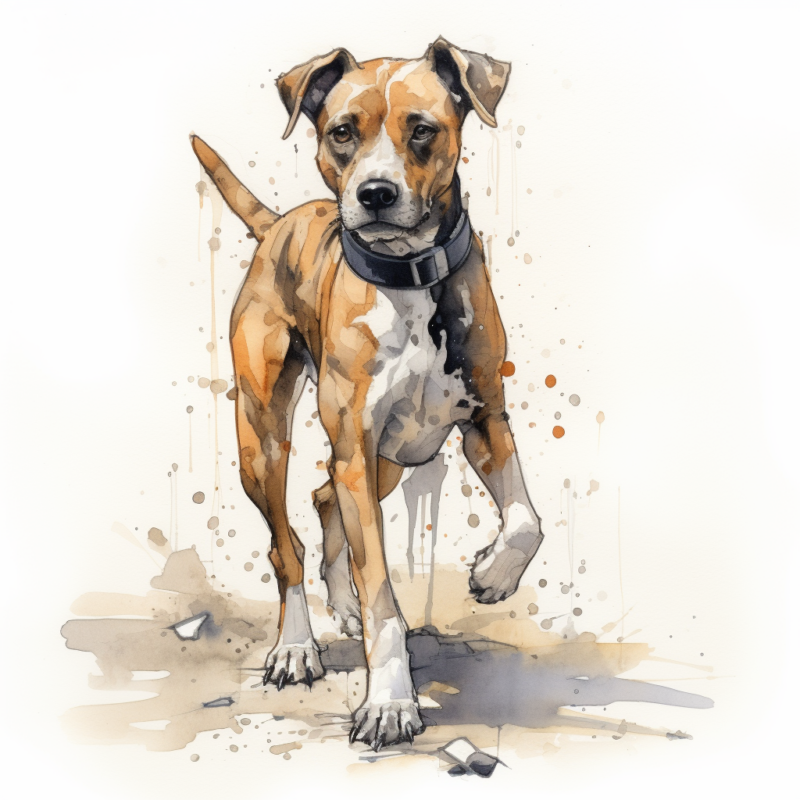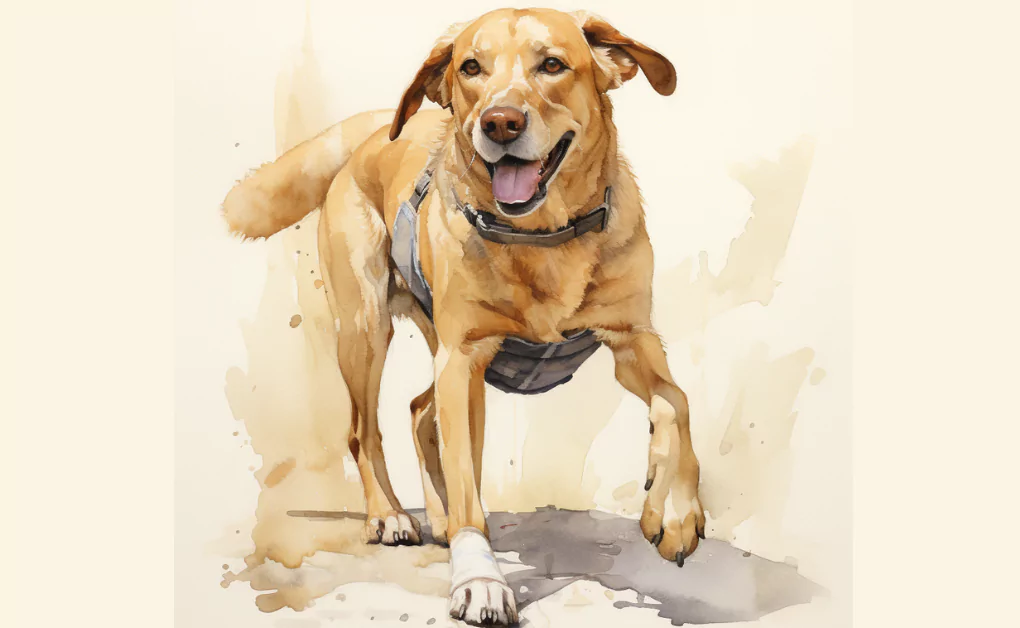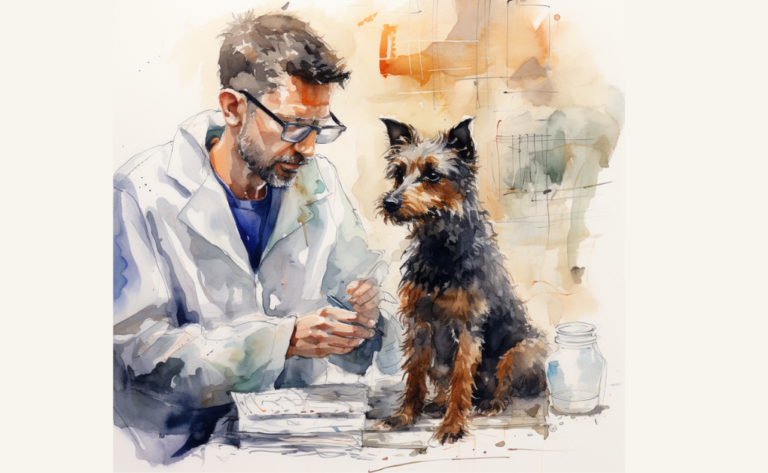What Are Traumatic Injuries In Dogs?
What is it?
How is it Treated?
Breed Predispositions
Great Danes Mastiffs Saint Bernards Labrador Retrievers Golden Retrievers Pointers Greyhounds Whippets Salukis
Introduction
In the cozy suburban tranquility of Elmwood, Bella, a spry, four-year-old Golden Retriever, was known for her playful enthusiasm and boundless energy. Her human companion, Emma, shared an unshakeable bond with her, enjoying long, playful runs and countless games of fetch in the local park. On a sunny afternoon not so long ago, their routine took a sudden, heartbreaking turn. Bella returned from their frolicking, not with her usual joyful bounce, but with a pained limp and a whimper. Emma’s heart dropped – Bella had suffered what appeared to be a traumatic injury. In this blog post, we’ll delve into the world of traumatic injuries in dogs.
Traumatic injuries in dogs, particularly in larger breeds, are frequent. Regrettably, many dog owners often don’t realize that their small animal companion has endured trauma or a severe injury until considerably after the injury. Sadly, a significant number of dogs experience complications due to trauma that has gone untreated. The good news is that most dogs will fully recover with critical care and suitable treatment. This is especially true even in leash-dependent dogs, where injuries can be more common due to increased outdoor exposure and potential accidents.
Types of Traumatic Injuries in Dogs
Trauma in dogs refers to physical injuries or emotional distress resulting from an accident, injury, or an overwhelming event. Traumatic injuries can range from mild to severe and impact various parts of a dog’s body, leading to temporary or permanent damage. Common causes of dog trauma include vehicle accidents, falls, fights with other animals, or abuse.
Fractures
Fractures in dogs refer to broken bones, which can occur for various reasons, such as accidents, falls, or traumatic events. Depending on the severity and location, fractures can range from simple breaks to more complex injuries. Here are some common types of fractures in dogs:
- Hairline or stress fractures: These are small cracks in the bone, often caused by repetitive stress or minor injuries. They can be challenging to detect but usually cause minimal pain and swelling.
- Simple or closed fractures: These fractures involve a clean break in the bone without damaging the surrounding skin. The broken ends of the bone remain within the body and don’t penetrate the skin.
- Compound or open fractures: These are more severe breaks where the bone protrudes through the skin, creating a high risk of infection and requiring more extensive treatment.
- Comminuted fractures: In this type of fracture, the bone shatters into several pieces, making it more challenging to repair and requiring more advanced treatment methods, such as surgery or internal fixation.
- Greenstick fractures: Common in young dogs with more flexible bones, these fractures involve an incomplete break, similar to a bent twig. One side of the bone may be cracked, while the other remains intact.
- Displaced fractures: These fractures involve misaligning bone fragments, requiring realignment and stabilization during treatment.
Dislocations
Dislocations in dogs occur when a bone is forced out of its normal position within a joint, usually due to trauma, injury, or a genetic predisposition to joint laxity. Dislocations can be painful, resulting in reduced mobility, instability, and possible long-term complications if not adequately addressed.
Common types of dislocations in dogs include:
- Hip dislocation (coxofemoral luxation): This occurs when the head of the femur (thighbone) is displaced from the hip socket (acetabulum). Hip dislocations can result from a traumatic event or hip dysplasia, a genetic condition that affects the stability and proper formation of the hip joint.
- Shoulder dislocation (glenohumeral luxation): This dislocation involves the displacement of the humerus (upper front leg bone) from the glenoid cavity (socket) in the scapula (shoulder blade). Shoulder dislocations are less joint than hip dislocations and are typically caused by trauma, such as a fall or collision.
- Patellar luxation: This condition involves the displacement of the patella (kneecap) from its normal position in the groove of the femur (thighbone). Patellar luxation can be congenital (present at birth) or develop over time due to injury or joint abnormalities. This dislocation is more common in small and toy breeds.
Lacerations and Abrasions
Lacerations and abrasions are two common types of skin injuries in dogs that can result from accidents, rough play, or encounters with sharp objects or surfaces.
- Lacerations: A laceration is a cut or tear in the skin caused by a sharp object, such as broken glass, a knife, or an animal’s teeth during a bite. Lacerations can vary in depth and severity, ranging from superficial cuts to deep wounds involving underlying tissues, muscles, or even bones. Depending on the depth and location, lacerations can lead to significant blood loss, infection, and damage to nearby structures.
- Abrasions: An abrasion is a superficial injury to the skin caused by friction or rubbing against a rough surface, such as pavement, carpet, or vegetation. Abrasions usually involve the outer layers of the skin and do not penetrate deeply. They are generally less severe than lacerations but can still be painful and prone to infection if not properly cared for.
Contusions
Contusions, also known as bruises, occur when blood vessels beneath the skin are damaged due to blunt force trauma, such as a fall, collision, or being hit by an object. The damage to the blood vessels causes blood to leak into the surrounding tissues, resulting in swelling, discoloration, and pain.
Sprains and Strains
Sprains and strains are common injuries in dogs that involve damage to the soft tissues surrounding joints and muscles. While both are painful and can limit a dog’s mobility, they differ in the structures they affect:
- Sprains: These injuries involve damage to the ligaments, which are fibrous bands of tissue that connect bones and stabilize joints. Sprains typically occur when a joint is twisted, overextended, or subjected to a sudden force, such as during a fall or an awkward landing from a jump.
- Strains: These injuries affect muscles and tendons, which connect muscles to bones. Strains usually result from overstretching, overuse, or repetitive stress on the muscle or tendon, such as during vigorous exercise or sudden movements.
Bite Wounds
Bite wounds in dogs occur when another animal bites a dog, typically another dog. These wounds can vary in severity, from superficial punctures and abrasions to deep lacerations that may damage underlying muscles, tendons, or bones. In addition, bite wounds risk infection due to the presence of bacteria in the mouth of the biting animal.

Internal Injuries
Internal injuries in dogs refer to damage or harm to the organs, blood vessels, or other internal structures within the body that are not visible externally. These injuries can be caused by various factors, including trauma (e.g., car accidents, falls), ingestion of toxic substances, or diseases that damage internal tissues. Internal injuries can be life-threatening and often require immediate veterinary attention.
Some common internal injuries in dogs include:
- Internal bleeding: This occurs when blood vessels rupture, causing blood to leak into the body cavities or surrounding tissues. Internal bleeding can result from trauma, blood clotting disorders, or cancer. Signs may include weakness, pale gums, increased heart rate, labored breathing, and collapse.
- Organ damage: Traumatic injuries or diseases can cause damage to vital organs such as the liver, kidneys, lungs, or heart. Symptoms depend on the affected organ but may include vomiting, diarrhea, difficulty breathing, or changes in heart rate.
- Gastric torsion (bloat): A life-threatening condition in which the stomach fills with gas and twists on itself, cutting off the blood supply. Signs include a distended abdomen, unproductive retching, excessive drooling, and restlessness.
- Ruptured bladder: A ruptured bladder can result from trauma or urinary blockage, causing urine to leak into the abdomen. Symptoms may include straining to urinate, abdominal pain, and lethargy.
- Ruptured spleen: Trauma or disease can cause the spleen to rupture, leading to internal bleeding. Signs may include pale gums, weakness, rapid heart rate, and collapse.
- Poisoning: Ingestion of toxic substances can cause internal damage, depending on the specific poison. Symptoms vary but may include vomiting, diarrhea, seizures, and loss of coordination.
Head Injuries
Various factors, including accidents, can cause head injuries in dogs, falls, or blunt force trauma. These injuries can range from mild to severe and affect the brain, skull, or surrounding structures. Therefore, immediate veterinary care is essential for assessing the severity of the injury and providing appropriate treatment.
Some common types of head injuries in dogs include:
- Concussions: A concussion occurs when the brain is briefly jolted or shaken, usually due to a direct blow or sudden impact. Symptoms may include temporary disorientation, unsteadiness, drowsiness, or loss of consciousness.
- Skull fractures: A skull fracture involves a break in the skull bone, which may or may not affect the underlying brain tissue. Symptoms can include swelling, bleeding, pain, and neurological signs such as seizures or altered mental state.
- Brain contusions: Contusions are bruises or bleeding within the brain tissue caused by direct trauma. Signs may include altered consciousness, abnormal behavior, seizures, or neurological deficits.
- Brain swelling (edema): Swelling can occur in response to injury or inflammation, putting pressure on the brain and potentially leading to life-threatening complications. Symptoms may include unresponsiveness, abnormal pupil response, seizures, or coma.
- Eye injuries: Trauma to the head can also cause injuries to the eyes, including corneal abrasions, retinal detachment, or damage to the optic nerve. Symptoms may include squinting, discharge, redness, swelling, or vision loss.
Causes of Traumatic Injuries in Dogs
Traumatic dog injuries can result from various causes, often related to accidents or environmental hazards. Recognizing these potential sources of injury can help dog owners take the necessary precautions to keep their pets safe. Some common causes of traumatic injuries in dogs include:
- Falls: Dogs can suffer from injuries from heights, such as jumping or falling from a balcony, window, or stairs. Such falls can lead to fractures, dislocations, or internal injuries.
- Vehicle accidents: Dogs can be injured by being hit by a car, motorcycle, or bicycle. These accidents can result in many injuries, from fractures and dislocations to internal bleeding and organ damage.
- Animal attacks: Dogs can be injured in fights with other dogs or attacks from larger animals, such as wild animals or livestock. Bite wounds, punctures, and lacerations can lead to infections or severe internal injuries.
- Blunt force trauma: Accidents involving blunt trauma, such as being struck by a swinging door or heavy object, can result in contusions, concussions, or even fractures.
- Sharp objects: Running into or stepping on sharp objects, such as broken glass, nails, or metal shards, can cause lacerations, punctures, or foreign body injuries.
- Sports and play-related injuries: High-energy activities like playing fetch, running, or agility training can lead to sprains, strains, or more severe injuries if the dog misjudges a jump or landing.
- Choking hazards: Ingesting inappropriate objects, such as toys or small household items, can lead to choking or gastrointestinal obstruction, which may require emergency surgery.
- Burns: Dogs can suffer burns from contact with hot surfaces or liquids, such as stoves, heaters, or boiling water. Electrical burns can also occur if a dog chews on live electrical cords.
- Drowning: Dogs can risk drowning in swimming pools, lakes, or other bodies of water if they cannot swim or find a way out.
Symptoms of Canine Traumatic Injuries
The manifestation of traumatic injuries in dogs can vary widely, contingent on the type and gravity of the injury. However, some prevalent signs could suggest your dog has suffered a traumatic injury:
- Your pet may display difficulty moving or bear an abnormal gait, hinting at the possibility that the injury occurred in one of their limbs.
- Your dog might have swelling or bruising at the location of the injury, indicative of possible tissue or vascular damage. In addition, there could be visible indications of trauma, such as lacerations, punctures, or abrasions.
- Signs of bleeding from a wound or mouth, nose, or rectum could be present. The dog might hold its body, head, or tail at an odd angle – a clear sign of abnormal body posture or position.
- A larger dog might show reluctance to move or bear weight on a specific limb. Aural cues such as whining, crying, or vocalizing in pain indicate that your pet has suffered an injury.
- Physiological changes, such as an increased heart rate or rapid, shallow breathing, can point to possible brain trauma, including primary or secondary brain injury.
- Signs of decreased blood flow to the brain could be pale or blue-tinged gums. In addition, your dog may display disorientation or confusion or even experience a loss of consciousness or unresponsiveness.
- Seizures, tremors, or gastrointestinal symptoms like vomiting or diarrhea, potentially containing blood, can suggest serious internal damage.
- Difficulty breathing or signs of respiratory distress are critical to monitor.
- Signs of shock, such as cold extremities, weak pulse, or rapid heart rate, can indicate a severe injury, such as one incurred from falling from a height or an encounter with a moving vehicle.
It is crucial to take your dog to a veterinary hospital immediately if you suspect they’ve experienced a traumatic injury. Regardless of whether the injury seems minor, underlying damage may not be immediately apparent. Prompt evaluation and treatment are essential in patients with severe injuries to prevent complications and ensure the well-being of injured animals.
Veterinary Diagnosis of Traumatic Injuries in Dogs
To diagnose traumatic injuries in dogs, a veterinarian will typically perform a combination of the following steps:
History
History diagnosis in dogs is a crucial part of the veterinary examination process. This process involves gathering comprehensive information about the dog’s medical history, lifestyle and observed symptoms, which helps the veterinarian to make an accurate diagnosis. Here’s how it works:

- Presenting Complaints: The veterinarian starts by asking the pet owner about the dog’s primary health concerns, like any observed changes in behavior, appetite, or physical condition. These concerns may include lethargy, coughing, vomiting, diarrhea, or weight changes.
- Medical History: The vet asks about the dog’s past medical history, which includes any previous illnesses or surgeries, allergies, and the response to any past treatments. Also, they will ask about the dog’s vaccination status and any preventive medications they are on.
- Lifestyle: Understanding the dog’s lifestyle can offer valuable insights into potential health risks. This includes the dog’s diet, exercise habits, whether it’s an indoor or outdoor dog, and if it has exposure to other animals.
- Habitat and Travel History: This information can be vital to diagnosis if the dog has recently traveled or lives in an area endemic to certain diseases (like Lyme disease or Leishmaniasis).
- Behavioral Changes: Changes in behavior often accompany illness. Information about new or unusual behaviors can provide crucial diagnostic clues.
- Symptom Timeline: Understanding when symptoms first appeared and how they have progressed over time can also be crucial for diagnosis.
- Breed-specific Diseases: Some dog breeds are predisposed to specific diseases. Knowing the breed can help narrow down potential health issues.
After gathering all this information, the veterinarian will typically perform a physical examination and may recommend additional diagnostic tests, such as blood tests, urine tests, or imaging studies, to confirm a diagnosis. The history diagnosis is essential in guiding the vet’s decision-making.
Physical Examination
A physical examination for traumatic injuries in dogs involves a comprehensive evaluation of the animal to identify any potential injuries or abnormalities associated with trauma. Here’s a typical step-by-step approach:
- Initial Assessment: The veterinarian begins with a rapid assessment to identify any life-threatening conditions. They’ll check vital signs like heart rate, respiratory rate, and temperature. The color of the dog’s gums can help assess blood circulation and oxygenation.
- Neurological Evaluation: The vet checks the dog’s level of consciousness and evaluates the dog for signs of head trauma or spinal injuries, such as varying pupil size, abnormal reflexes, or difficulty moving.
- Cardiovascular Examination: The vet listens to the dog’s heart and lungs with a stethoscope to detect abnormalities like irregular heartbeats, heart murmurs, or abnormal lung sounds. They’ll also check the pulse quality.
- Abdominal and Thoracic Palpation: By carefully feeling the dog’s abdomen and chest, the vet can identify signs of internal injuries, like abdominal pain, distention, or abnormal masses. They may also detect broken ribs or fluid in the chest.
- Musculoskeletal Examination: The vet carefully examines the dog’s limbs and spine for signs of fractures, dislocations, or other musculoskeletal injuries. They’ll look for swelling, pain, or abnormal movement.
- Skin and Coat Examination: The vet checks for signs of external injuries, like cuts, bruises, burns, or bite wounds. They’ll also examine the skin and coat for other signs of trauma, like hair loss, redness, or swelling.
- Oral and Ocular Examination: The vet inspects the dog’s mouth for dental injuries or signs of shock (such as pale gums) and the eyes for signs of trauma, such as redness, swelling, or abnormal pupil size.
Suppose the physical examination suggests that the dog has sustained traumatic injuries. In that case, the vet may recommend additional diagnostic tests, such as X-rays, ultrasound, or blood tests, to better understand the extent and nature of the injuries. It’s essential to seek immediate veterinary care if a dog has experienced trauma, as some injuries may not be immediately apparent but can still be severe or life-threatening.
Palpation and Manipulation
Palpation and manipulation are key components of a physical examination for traumatic injuries in dogs, helping veterinarians identify any abnormalities, assess the extent of injuries, and determine the most appropriate course of treatment. Here is how they are typically performed:
- Palpation: Palpation involves using hands to feel the body for abnormalities. The veterinarian will gently press and feel various parts of the dog’s body, including the abdomen, chest, limbs, and spine. This process can help identify signs of internal injuries, such as swelling, pain, abnormal masses, or fluid accumulation. It can also help detect broken bones or dislocations in the limbs and spine. In the abdomen, palpation can reveal information about the size and position of organs and help identify any unusual masses or fluid buildup.
- Manipulation: Manipulation involves moving the dog’s joints and limbs to assess its range of motion and identify any signs of pain or discomfort. The veterinarian may flex, extend, and rotate each joint to check for abnormalities. This process is particularly important for identifying potential fractures, dislocations, or other musculoskeletal injuries that could be causing the dog pain or limiting its mobility.
During palpation and manipulation, the veterinarian will observe the dog’s reactions to identify areas of discomfort or pain. It’s important to note that a trained professional should only perform these procedures, as improper handling can potentially worsen the dog’s injuries. If the palpation and manipulation suggest serious injuries, further diagnostic tests such as X-rays, ultrasounds, or CT scans may be required better to understand the extent and nature of the injuries
Laboratory Tests
Laboratory tests are critical in diagnosing traumatic injuries in dogs, helping veterinarians assess the extent of internal damage, monitor organ function, and guide treatment decisions. Some commonly used laboratory tests in cases of traumatic injury include:
- Complete Blood Count (CBC): This test measures the number of red blood cells, white blood cells, and platelets in a blood sample. It can help identify signs of infection, inflammation, anemia, or clotting disorders that may result from trauma.
- Blood Chemistry Panel: This test evaluates various chemicals and enzymes in the blood to assess the function of vital organs such as the liver, kidneys, and pancreas. Abnormal levels can indicate organ damage or dysfunction due to trauma.
- Coagulation Profile: This test assesses the blood’s ability to clot, which is crucial in cases of traumatic injury where bleeding may be a concern. It can help detect clotting disorders that could lead to excessive bleeding or clot formation.
- Urinalysis: This test evaluates the urine for signs of urinary tract injury or dysfunction and potential kidney function issues. It can also provide information about hydration status, which can be impacted by traumatic injury.
- Cytology: This involves examining cells under a microscope. For instance, if the dog has wounds, fluid or tissue samples may be collected and examined to identify bacteria, fungi, or other pathogens that could lead to infection.
- Crossmatching and Blood Typing: If the dog has lost a significant amount of blood and requires a transfusion, these tests are performed to ensure the donor blood is compatible.
These tests provide valuable information about the dog’s overall health and the impact of the traumatic injury on various body systems. However, the specific tests ordered will depend on the nature of the injury and the dog’s clinical signs. In some cases, further diagnostic imaging or other advanced tests may be necessary for a full assessment.
Additional Diagnostics
In some cases, the vet may recommend additional diagnostic tests, such as an
- endoscopy
- arthroscopy
- cerebrospinal fluid analysis
- depending on the specific injury and the dog’s clinical signs.
After the veterinarian has gathered all the necessary information and completed the diagnostic tests, they will provide a diagnosis and discuss the best treatment for your dog’s injury. Treatment options will depend on the nature and severity of the injury, the dog’s age, overall health, and any specific needs or concerns you may have.
Emergency Treatments for Traumatic Injuries in Dogs
Emergency medicine for traumatic injuries in dogs is designed to stabilize the animal, manage pain, and address any life-threatening conditions before undertaking further diagnostics and delivering definitive treatment. Here are typical emergency treatments for traumatic injuries in dogs often carried out in emergency rooms or animal hospitals:
- Stabilization: The top priority in an emergency is stabilizing the dog, which might involve administering oxygen therapy, providing intravenous fluids to uphold blood pressure and hydration, and ensuring the dog’s body temperature remains within normal parameters.
- Pain Management: Administering pain relief is critical for injured dogs. Veterinarians may use various medications such as:
- opioids
- nonsteroidal anti-inflammatory drugs (NSAIDs)
- local anesthetics
- Wound Care: If the dog has visible injuries like puncture wounds or lacerations, the veterinarian will clean and address these wounds to prevent infection and aid healing. This might involve rinsing the wound with sterile saline, removing foreign debris, and applying topical antiseptics or antibiotics.
- Hemorrhage Control: The veterinarian will enact measures to halt the blood loss if the dog is dealing with substantial bleeding. This might include applying direct pressure, employing bandages or tourniquets, or using medications to enhance blood clotting.
- Management of Fractures and Dislocations: If the dog has a suspected fracture or dislocation, the veterinarian may apply a temporary splint or bandage to stabilize the area and prevent further injury while more definitive treatments, like elbow surgery, are planned.
- Shock Treatment: If the dog is in shock due to blood loss, dehydration, or other factors, the veterinarian will address the underlying cause and support the dog’s cardiovascular system. This could include intravenous fluids, transfusions, or medications to enhance heart function and blood flow.
Following the stabilization of the dog, the veterinarian will ascertain the most suitable course of action for definitive treatment, which may include surgery, medication, or other interventions, depending on the specifics of the injury and the dog’s overall health. In the case of multiple injuries or management of traumatic brain injury, anesthesia or sedation might be necessary. The potential for secondary injury will also be considered.
How to Prevent Traumatic Injuries in Dogs
Preventing traumatic injuries in dogs requires active efforts to reduce the possibility of accidents and hazards. Here are some actions you can take to safeguard your leash-dependent dog from injuries, contributing positively to your pet’s health:
- Vigilance: Always keep an eye on your dog, particularly when outdoors or in unfamiliar territories. Monitor your pet’s activities to ensure they do not indulge in risky behaviors or encounter potential threats.
- Leash Training: Inculcate the habit of walking on a leash in your dog and use it consistently when you are outside, especially in areas with traffic or other potential dangers. This gives you control over your dog and prevents them from running into danger.
- Yard Security: Ensure your yard is securely fenced to keep your dog from escaping and running into hazards like busy streets or aggressive animals. Regularly check the fence for any holes or weak points your dog might exploit.
- Socialization and Training: Appropriate socialization and obedience training can teach your dog to behave suitably around other animals and humans, decreasing the risk of conflicts and injuries from aggressive behavior.
- Prudent Interactions with Other Dogs: Exercise caution when your dog meets or plays with new dogs, particularly if the other dog’s temperament is unknown. Always supervise their interactions to avert aggressive confrontations or rough play that could result in injury.
- Maintain a Safe Environment: Ensure your home environment lacks hazards that might injure your dog. This includes securing potential threats like toxic substances, sharp objects, or small items that your pet may ingest and cause choking or intestinal blockage.
- Temperature Regulation: Avoid exposing your dog to extreme heat or cold for prolonged durations, which can lead to heatstroke or frostbite. Instead, always provide a suitable shelter and access to fresh water.
- Regular Veterinary Check-ups: Regular appointments with your veterinarian can help identify any health issues that could heighten your dog’s injury risk or make them more prone to accidents. Early detection and medical management of health concerns can improve your dog’s safety and health.
- Spaying or Neutering Your Pet: Spaying or neutering your dog can help curtail aggressive or wandering behaviors, reducing the risk of injuries related to fights or accidents.
- Safety During Car Rides: When traveling with your dog, ensure they are securely fastened with a dog harness, crate, or carrier to prevent injury in case of sudden stops or accidents.
Even though removing all injury risks is impossible, these steps can significantly lower the chance of traumatic injuries in your dog, such as spinal fractures, which may not be apparent immediately but can occur at the time of the accident. Also, be alert for any biochemical changes your dog experiences that may indicate your pet has injured a part of the body, like bone fractures or damage to the body wall, particularly the neck and spine. By taking these precautions, you help ensure their safety and well-being.
Frequently Asked Questions
Disclaimer: The information provided on this veterinary website is intended for general educational purposes only and should not be considered as a substitute for professional veterinary advice, diagnosis, or treatment. Always consult a licensed veterinarian for any concerns or questions regarding the health and well-being of your pet. This website does not claim to cover every possible situation or provide exhaustive knowledge on the subjects presented. The owners and contributors of this website are not responsible for any harm or loss that may result from the use or misuse of the information provided herein.







